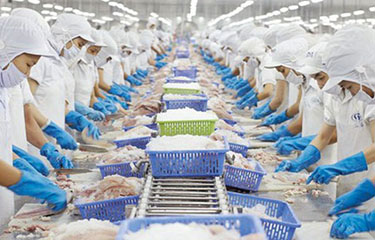Vietnam has surpassed USD 10 billion (EUR 9.4 billion) in seafood exports thus far in 2022, reaching an all-time high for the country, thanks to a post-Covid recovery in global demand.
But high global inflation and an uncertain Chinese market have the country’s seafood executives anxious about a possible downturn.
Vietnam took in USD 10.17 billion (EUR 9.57 billion) from its seafood exports between January and November 2022, a 27.4 percent year-over-year increase, meeting the country’s long-sought-after goal, first set in 2011.
The U.S. was Vietnam’s top seafood market, accounting for USD 2.03 billion (EUR 1.91 billion) of sales thus far in 2022, up 8.6 percent year-on-year. Japan was Vietnam’s second-biggest market, with USD 1.58 billion (EUR 1.49 billion) in sales, up 30.4 percent from a year earlier. Vietnam’s seafood sales to China jumped 71.3 percent to USD 1.47 billion (EUR 1.38 billion), and South Korea, with USD 876.6 million (EUR 825.2 million) in sales, had 21.5 percent growth.
On 10 December, 2022, the Vietnam Association of Seafood Exporters and Producers (VASEP) held a ceremony to celebrate the milestone, and the fact that Vietnam has become the third-largest seafood exporter in the world in terms of value, after China and Norway.
Despite the triumphant atmosphere, the short- and medium-term forecast for Vietnam’s seafood exports has given the industry cause for concern. Most of the industry’s growth came in the first half of 2022, as demand bounced back from the depths of the Covid-19 pandemic. In recent months, sales have declined, with customs data revealing Vietnam’s seafood export value dropped to its lowest level in nine months in November, at USD 788.8 million (EUR 742.6 million), down 13.3 percent year-on-year. While sales to Japan surged 11 percent year-on-year to USD 151.4 million (EUR 142.5 million), and sales to China increased 6.4 percent to USD 127.2 million (EUR 119.7 million), sales to all of Vietnam’s other primary export destinations declined. Sales to South Korea dropped 5.6 percent USD 76 million (EUR 71.5 million); sales to Thailand fell 0.1 percent to USD 28.4 million (EUR 26.7 million); sales to Australia dove 8.7 percent to USD 25.4 million (EUR 23.9 million); sales to the U.K. sunk 23.3 percent to USD 18.6 million (EUR 17.5 million); and sales to Canada fell 32.1 percent to USD 17.6 million (EUR 16.5 million).
In a recent survey of executives with 117 Vietnamese seafood companies conducted by Vietnambiz, 71 percent of respondents said they expected 2023 to be more difficult than 2022, with 22 percent saying they believe 2023 will be “extremely difficult” for their business, and only 7 percent optimistic about their market prospects in the coming year. High inflation leading to lower demand and increased stockpiles, fluctuating exchange rates, monetary tightening, a potential global economic recession, and rising competition from Ecuador and India in the shrimp market led the list of reasons given for the pessimism.
At a shrimp-focused seminar in Vietnam in early December, Minh Phu CEO Le Van Quang said his company’s export value should reach USD 600 million (EUR 565 million) for 2022, down from more than USD 650 million (EUR 612 million) in 2021, as the firm’s October and November sales tumbled. Quang said he is fearful many shrimp farmers in Vietnam will have to suspend their farming activity if sales continue to slump.
Fimex (Sao Ta), another of Vietnam’s largest shrimp exporters, has also reported a drop in sales due to high inflation and competition from low-priced shrimp from Ecuador and India. In November 2022, the company’s exports, including sales of agricultural products, declined 31.5 percent year-on-year to USD 13.9 million (EUR 13.1 million). The company produced 1,478 metric tons (MT) of processed shrimp in November, down 37.4 percent from October 2022, but output matched with lower sales, as it sold just 1,116 MT of shrimp in November, down 34.2 percent.
Vinh Hoan, Vietnam’s top pangasius exporter, also experienced a contraction in exports, to VND 893 billion (USD 38.2 million, EUR 35.9 million) in November 2022, down 10 percent year-on-year and 13 percent month-on-month. Vinh Hoan’s sales to the U.S., China, and Europe all fell.
While sales have dropped, material prices have risen. Between 10 to 14 December, the average price for pangasius feed rose VND 300 (USD 0.13, EUR 0.12) per kilogram, an industry source from a leading feed producer told SeafoodSource, blaming the increase on the rising costs of key inputs. The pangasius sector will continue to struggle through Q1 2023 due to falling purchasing from China, the source said.
Photo courtesy of Vinh Hoan







